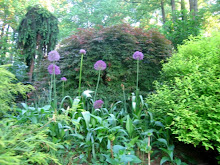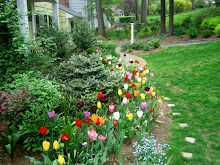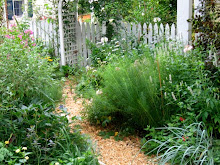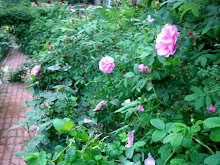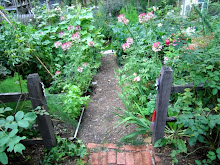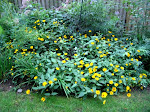
This Christmas season, I'm trying to decorate the house with as many things from the garden as possible. When you make your own decorations, you benefit from (i) fresher materials than what you can buy, (ii) the joy of bringing your garden indoors, and (iii) saving a lot of money.
~
Today, I worked on the wreath for the front door. It was an easy project that took a few hours. It is extremely fulfilling to see the wreath form before your eyes.
~
1. Gather together your supplies. You will need: (a) a wire base--I used a wire frame I purchased from Michael's, but you can also purchase them online at the Maine Wreath Co.; (b) floral wire; (c) pruners; and (d) wire cutters.
~
2. Cut a variety of evergreen materials from your garden. You can cut branches or just tips. Ultimately, you will use pieces that are six to eight inches long, so keep this in mind when cutting. I think of this as doing my spring pruning a few months early. After several years of doing so I see no adverse effects on the plants. If anything, they grow more robustly the following season.
~
This year, I used white pine, leyland cypress, ilex and rose hips from my garden and incense cedar, which I purchased. You could also use boxwood, southern magnolia, fir, juniper, holly, spruce, yew, arborvitea, winterberry, nandina, euonyonomous, and many others--the possibilities are only limited by availability.
~
3. Make your posies. Once you have gathered your supplies and have chosen which greens look good together, use them to make posies. In your hand, gather together a small arrangement of greens and berries. Wire the greens together by wrapping the floral wire around them, fanning out the arrangement as you wrap. Continue making the posies and positioning them around the wreath base. When all the posies cover your base, proceed to the next step.
~
4. Attach your posies to the wire base. Attach the first posy by wrapping the floral wire around both it and the wreath frame several times. Once the first posy is in place, continue to add in the others each time making sure each additional one covers up the base of the last one.
~
5. Add the finishing touches. After the wreath base is covered you can add additional embellishments of pine cones or dried flowers with hot glue. Using the floral wire, make a hanging loop and attach this to the wreath base. You are now ready to hang your wreath.
~
6. Extend the life of your wreath (optional). If you would like to extend the life of your wreath, you can spray it with an antidessicant or mist it with water once a day.
~
Related posts:
 "My favorite thing in the garden is making flower arrangements. I like putting different flowers together. My favorite color is pink, so a lot of my vases have pink in them. One of my favorite plants is the hibiscus, but the flowers only stay good in a vase for one day. Phlox are good too."
"My favorite thing in the garden is making flower arrangements. I like putting different flowers together. My favorite color is pink, so a lot of my vases have pink in them. One of my favorite plants is the hibiscus, but the flowers only stay good in a vase for one day. Phlox are good too." "My favorite thing in the garden is harvesting vegetables. There are so many different ones to find in the vegetable garden. My favorites to harvest are the tomatoes."
"My favorite thing in the garden is harvesting vegetables. There are so many different ones to find in the vegetable garden. My favorites to harvest are the tomatoes." "My favorite thing about gardening is looking at the flowers. Some of my favorite flowers are daffodils, tulips, and muscari. Muscari is my favorite because it looks like it has bells."
"My favorite thing about gardening is looking at the flowers. Some of my favorite flowers are daffodils, tulips, and muscari. Muscari is my favorite because it looks like it has bells."









 A snowdrop in the Front Border
A snowdrop in the Front Border










































